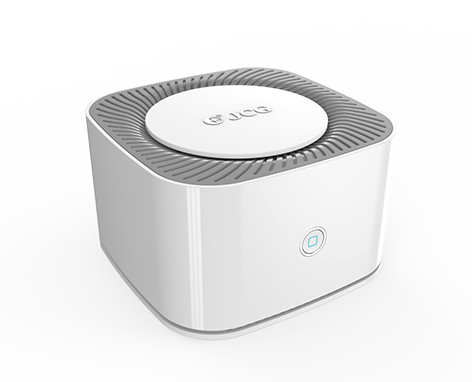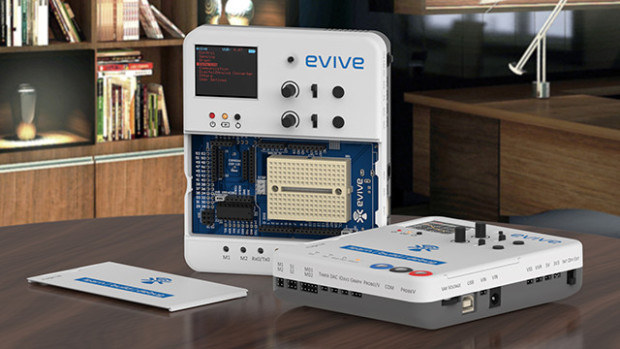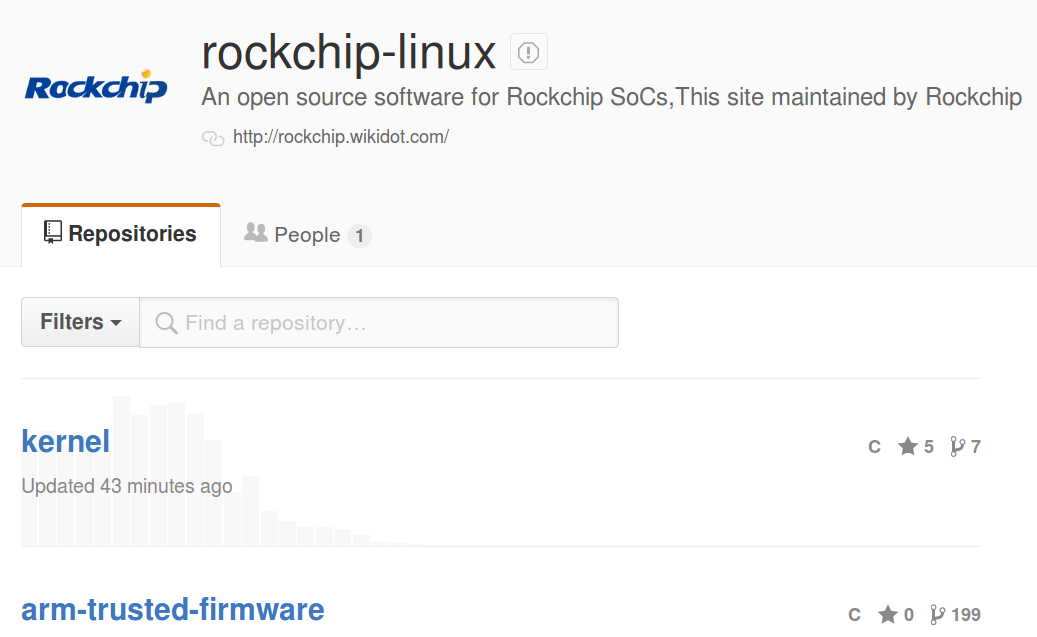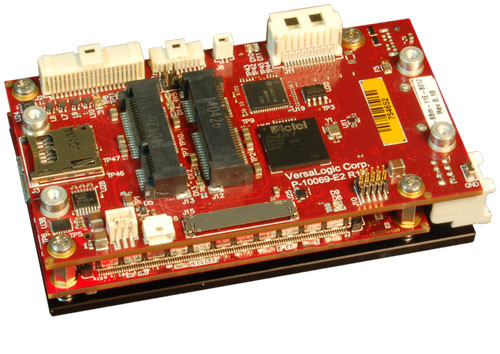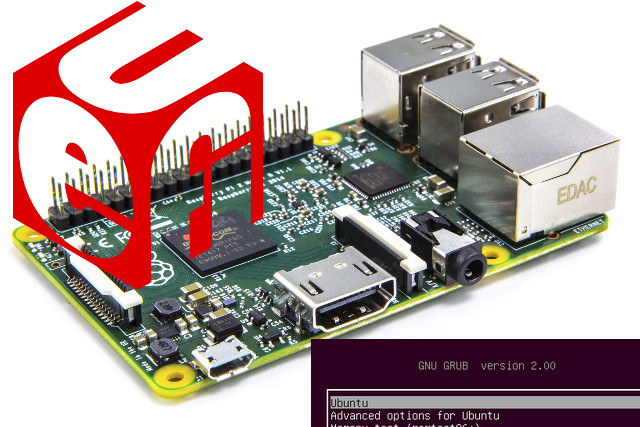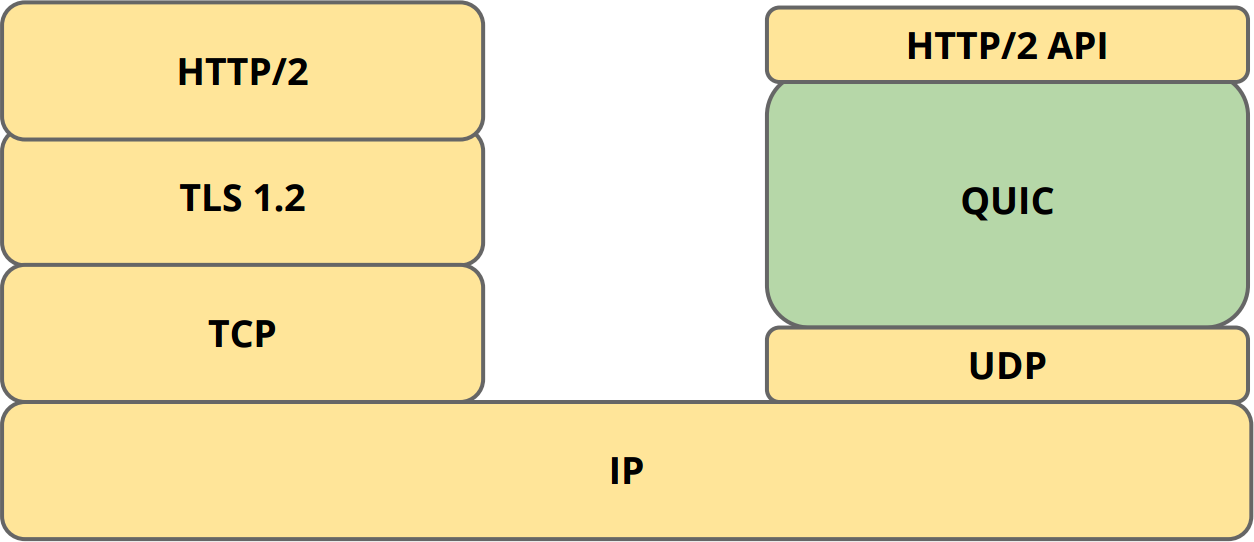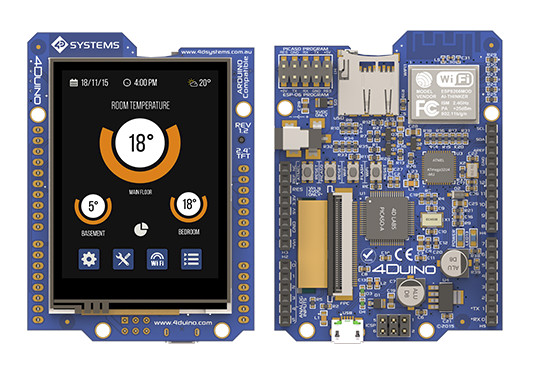There are plenty of Amlogic S905 TV boxes on the market, but Hacker H3 has some notable features such as an internal 2.5″ SATA bay, as well as MediaTek MT7628AN WiSoC and MT7612E 802.11ac 867Mbps chip to provide router functionality via one WAN port, two LAN ports, and WLAN. Hacker H3 media gateway specifications: Media SoC – Amlogic S905 quad core Cortex A53 processor @ up to 2.0GHz with penta-core Mali-450MP GPU System Memory – 1GB DDR3 @ 1866MHz Storage – 16 or 64GB eMMC flash + 1x SATA bay up to 6TB Network SoCs – Mediatek MT7628AN MIPS 24KEc CPU @ 580MHz + Mediatek MT7612E 867Mbps 802.11ac chipset Video Output – HDMI 2.0 port up to 4K @ 60 Hz Audio Output – HDMI + 3.5mm audio jack Connectivity WiFi 802.11 b/g/n up to 300 Mbps, 802.11ac up to 866 Mbps (AC1200 router) with two built-in antennas 2x 10/100M […]
Evive is an Arduino Compatible Platform with Enclosure, Lots of I/Os, Buttons, and an 1.8″ Display (Crowdfunding)
Engineers at Agilo Technologies, an Indian startup based in Kanpur, Uttar Pradesh, felt that the wire mess often produced while learning or prototyping with Arduino boards could be an issue, and it was easy to mis-wire your setup, so they’ve decided to create a user and student friendly Arduino compatible system with many of the items you’d normally use with Arduino board such as buttons, probes inputs, an 1.8″ color display, headers for ESP8266, Bluetooth, and XBEE moduels, etc.. and all of that enclosed in a neat case. Evive was born. Evive specifications: MCU – Atmel ATmega2560 8-bit AVR MCU @ 16 MHz with 256KB flash, 4KB EEPROM, 8KB SRAM Storage – micro SD slot up to 32GB Display – 1.8″ TFT display; 160×128 resolution; 18-bit color User inputs – Tactile and slide switches, joysticks, and potentiometers Probes inputs – Voltage / Intensity sensing inputs USB – USB device port Expansion Headers […]
Official Rockchip Github Account and Wiki Launched
Following the popularity of RK3066 and RK3188 processors in 2013, a community of developers for Rockchip Linux and Android development was created with corresponding linux-rockchip github account, mailing list and #linux-rockchip IRC channel, and now most of the information can be gathered from development board manufacturers like Firefly. However, I’ve just been pointed out to some VA-API driver for Rockchip RK32xx processor, on rockchip-linux (not linux-rockhip) github account, with the following tagline: An open source software for Rockchip SoCs, This site maintained by Rockchip The only person currently registered to this account, Jacob Chen (陈豪), is a software engineer working for Rockchip, so it does indeed look to be official. The github account also links to rockchip.wikidot.com with links to communication channels established by linux-rockchip community, and lots of entries about Linux, Android, U-boot, and so on, most of which are currently placeholders. So it still looks like work in […]
VersaLogic Osprey is an Industrial & Military Grade Intel Bay Trail Single Board Computer
Versalogic Osprey “Embedded Processing Unit” (EPU) is a single board computer powered by Intel Bay Trail-I CPU modules with 2 to 4GB RAM, up to 8GB flash, dual Gigabit Ethernet, two mini PCIe slots, working at industrial temperatures (-40 to 85°C), and compliant with MIL-STD-202G military standard for shocks and vibrations. VersaLogic Osprey VL-EPU-3311 specifications: SoC Intel Atom E3845 quad core processor @ 1.91GHz with Intel HD graphics or Intel Atom E3827 dual core processor @ 1.75GHz with Intel HD graphics or Intel Atom E3815 single core processor @ 1.46GHz with Intel HD graphics System Memory – 2GB or 4GB DDR3L (soldered) Storage 8GB eMMC flash with E3845 model; 4GB eMMC flash with E3827 model; no flash for E3815 model MicroSD slot SATA 2.0 port with latching connector mSATA via mini-PCIe slot Display Single-channel 18/24-bit LVDS up to 1024×768 @ 60Hz Dual mini-DisplayPort++ with HDMI and audio support up to […]
U-Boot Now Supports UEFI on 32-bit and 64-bit ARM Platforms
Intel/AMD x86 based computers now boot via a standard UEFI binary, which can load grub2, allows you to update the command line as needed, or select different version of the Linux kernel. On ARM everything is a little more complicated and messy, as bootloaders such as U-boot need to support different configurations formats. Alexander Graf has been working on implementing UEFI support in U-boot, and it’s now supported by U-boot mainline and enabled by default for 32-bit and 64-bit ARM platforms, but not x86-64 (yet). That means you should now be able to boot any ARM boards supported by mainline U-boot through UEFI. Alexander gave a presentation about his work at an openSUSE event in June, and demonstrated u-boot with UEFI, and GRUB2 support with an openSUSE image running on a Raspberry Pi board. Thanks to David for the tip. Jean-Luc Aufranc (CNXSoft)Jean-Luc started CNX Software in 2010 as a […]
Google QUIC is a Secure UDP Protocol Aiming to Replace TCP + TLS
A lot of traffic over the Internet goes through secure https connections. Under the hood this requires a 3-way handshake to establish a TCP connection, followed by even more packets exchanged between the client and server to negotiate TLS in order to establish a secure connection. Google is now working one the new experimental QUIC protocol that uses the “send and forget” UDP protocol, together with its own crypto, and its own way to making sure the connection is properly establish. The whole idea about QUIC is to reduce the effect of latency (e.g. ping time) by exchanging less messages to achieve the same secure connectivity. For example, if there’s a 200ms latency between a server and a client, and if a TCP connection requires 4 packets, while a QUIC/UDP connection requires only 1 packet, you’ll save about 600ms. One downside with UDP according to Jim Roskind, designer of QUIC, […]
4Duino-24 is an Arduino compatible 2.4″ Color IoT Display Module with Atmel MCU and ESP8266 Module
I played with ITEAD Studio NEXTION serial color displays for Arduino boards and the likes a few months ago, and while the hardware seems good and the company offer a large choice of 2.4″ to 7″ models at a very affordable price, I didn’t find the Windows software to create the user interface to be very user-friendly. 4D Systems, an Australian company specializing in “graphics solutions”, will soon launch a similar 2.4″ display, but integrated into an Arduino compatible board also featuring an ESP8266 module for WiFi connectivity. 4Duino-24 “LCD IoT Display Module” specifications: MCU – Atmel ATmega32U4 micro-controller with 32KB flash, 2.5KB SRAM, 1KB EEPROM Storage – micro SD card slot (FAT16 support) for data and logging WiFi Module – ESP8266 based with 802.11 b/g/n connectivity, 1MB flash, support for Wi-Fi Direct (P2P), soft-AP Display – 2.4” LCD-TFT resistive touch display module with 240×320 resolution, 65K colors, and powered […]
DVB Channel Editor Tools for K1 Plus T2 S2 Android TV Box
K1 Plus T2/S2 is one of the most popular Android TV boxes with digital tuners, including both DVB-T2/T/C and DVB-S2/S tuners, and I get frequent comments and questions on K1 Plus T2 S2 review. One of the often asked request is a channel editor to use on a computer, in order to change the names, the order of channels, and set favorites. You can export the DVB data from the DTV app in Android with all data stored in dtv_user_data directory, and in theory, one web based editor is supposed to let you do just that, but it did not work for me. Another option shared with us by gabywap is K1_Plus_Editor.exe (Mirror) developed by Sm0ke, who appears to mostly frequent Russian forums. So I downloaded it, and launched it with Wine in Ubuntu 16.04, but the channel data I had could not load, and the program showed some error […]


